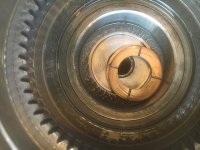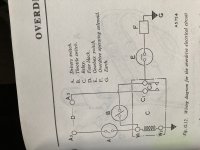AUSMHLY
Yoda
Offline
Why does my overdrive lose all pressure so quickly, when it seems it should not?
This was copied from The Healey Technical Archives:
Start the engine in neutral and adjust the idle to about 1500 rpm. Without feeding any gas, place the gearshift into 4th (OD off) gear while watching the gage. The pressure should increase from 0 to 300psi in TWO TO THREE SECONDS. In another 10 seconds, the pressure should have gone from 300 to 470psi, where it should remain constant. Keep the car running at 1500 rpm while watching the gage - it should stay rock steady at 470 to 490psi.
Now engage OD while watching the gage - it should drop about 100 psi when OD kicks in, then climb back up to 470-490 in about 5 seconds. While watching the gage, place the gearbox into neutral, hit the brakes, turn off the engine. When the rear wheels stop turning, the pressure will drop slowly into the low 400's, then continue dropping at a rate of about 10 psi per minute down to about 250-300 psi where it should stay for several hours. These numbers are not absolute, simply my records over the past 30 years. However, they will give you a benchmark of how well your OD hydraulic system is functioning and if further repairs are necessary.
Here's how long it takes for the pressure drop:
Car on jack stands.
4th gear, 1500 rpm, OD off, 450 psi.
4th gear, 1500 rpm, OD engaged, drops immediately to 200 psi, 5 seconds to 450 psi.
4th gear, 1500 rpm, OD off, goes/stays at 410 psi.
Into neutral, brakes on, ignition off, 410-300psi takes 3 seconds, then 7 seconds to 0 psi.
What do I need to look into why the pressure drops so fast to 0?
Would the O-Ring conversion accumulator housing/pistion from AH Spares fix this?
> O-RING CONVERSION-accumulator piston <
Would replacing the accumulator pressure spring help? (Mine has a washer, but I believe there was a Healey tech notice that recommended adding a washer.)
Would replacing the spring/plunger/ball bearing for both the operating valve and non-return valve help?
Probable issue of the non-return valve seat not smooth enough to make a seal?
Thoughts anyone...

This was copied from The Healey Technical Archives:
Start the engine in neutral and adjust the idle to about 1500 rpm. Without feeding any gas, place the gearshift into 4th (OD off) gear while watching the gage. The pressure should increase from 0 to 300psi in TWO TO THREE SECONDS. In another 10 seconds, the pressure should have gone from 300 to 470psi, where it should remain constant. Keep the car running at 1500 rpm while watching the gage - it should stay rock steady at 470 to 490psi.
Now engage OD while watching the gage - it should drop about 100 psi when OD kicks in, then climb back up to 470-490 in about 5 seconds. While watching the gage, place the gearbox into neutral, hit the brakes, turn off the engine. When the rear wheels stop turning, the pressure will drop slowly into the low 400's, then continue dropping at a rate of about 10 psi per minute down to about 250-300 psi where it should stay for several hours. These numbers are not absolute, simply my records over the past 30 years. However, they will give you a benchmark of how well your OD hydraulic system is functioning and if further repairs are necessary.
Here's how long it takes for the pressure drop:
Car on jack stands.
4th gear, 1500 rpm, OD off, 450 psi.
4th gear, 1500 rpm, OD engaged, drops immediately to 200 psi, 5 seconds to 450 psi.
4th gear, 1500 rpm, OD off, goes/stays at 410 psi.
Into neutral, brakes on, ignition off, 410-300psi takes 3 seconds, then 7 seconds to 0 psi.
What do I need to look into why the pressure drops so fast to 0?
Would the O-Ring conversion accumulator housing/pistion from AH Spares fix this?
> O-RING CONVERSION-accumulator piston <
Would replacing the accumulator pressure spring help? (Mine has a washer, but I believe there was a Healey tech notice that recommended adding a washer.)
Would replacing the spring/plunger/ball bearing for both the operating valve and non-return valve help?
Probable issue of the non-return valve seat not smooth enough to make a seal?
Thoughts anyone...

 Hi Guest!
Hi Guest!

 smilie in place of the real @
smilie in place of the real @
 Pretty Please - add it to our Events forum(s) and add to the calendar! >>
Pretty Please - add it to our Events forum(s) and add to the calendar! >> 


